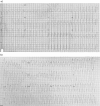A Tale of Two Conditions: Pediatric Brugada Syndrome Unveiled-Navigating the Challenges of Coexisting Arrhythmia and Fever-Induced ECG Pattern
- PMID: 39726150
- PMCID: PMC11671451
- DOI: 10.1111/anec.70009
A Tale of Two Conditions: Pediatric Brugada Syndrome Unveiled-Navigating the Challenges of Coexisting Arrhythmia and Fever-Induced ECG Pattern
Abstract
Background: Brugada syndrome (BrS) is an inherited channelopathy characterized by right precordial ST-segment elevation. This study investigates the clinical and genetic characteristics of children with BrS in Hong Kong.
Methods: A retrospective review was conducted at the only tertiary pediatric cardiology center in Hong Kong from 2002 to 2022, including all pediatric BrS patients under 18 years old. The diagnosis of BrS was established with a type 1 ECG pattern detected spontaneously or induced by flecainide, excluding secondary causes.
Results: Eight probands of mean age 10 years old were identified. Male dominance was observed (6 boys vs. 2 girls). The mean follow-up duration was 4.6 years (Median 3.5 years). Patients had type 1 ECG pattern either spontaneously (n = 4) or provoked by flecainide (n = 4). Fever was present in seven patients at the initial presentation, and two patients experienced aborted cardiac arrest and one had symptomatic ventricular tachycardia. All symptomatic patients received implantable cardioverter-defibrillator placement. Five asymptomatic patients (62.5%) were diagnosed with BrS through ECG during febrile illness, and they remained asymptomatic following conservative management involving strict fever control and medication avoidance. Two patients with mixed phenotype (one with long QT syndrome and another with ectopic atrial tachycardia) required antiarrhythmics and one patient received transcatheter ablation for atrial tachycardia to achieve optimal arrhythmia control.
Conclusion: Fever plays a significant role in unmasking BrS in children. Asymptomatic children with BrS managed conservatively have a favorable prognosis. Difficult arrhythmia control was found in patients with mixed phenotype.
Keywords: coexisting arrhythmia; focal atrial tachycardia; long QT syndrome; pediatric Brugada syndrome; subcutaneous ICD.
© 2024 The Author(s). Annals of Noninvasive Electrocardiology published by Wiley Periodicals LLC.
Conflict of interest statement
The authors declare no conflicts of interest.
Figures


Similar articles
-
Impact of clinical and genetic findings on the management of young patients with Brugada syndrome.Heart Rhythm. 2016 Jun;13(6):1274-82. doi: 10.1016/j.hrthm.2016.02.013. Epub 2016 Feb 24. Heart Rhythm. 2016. PMID: 26921764
-
[Doubts of the cardiologist regarding an electrocardiogram presenting QRS V1-V2 complexes with positive terminal wave and ST segment elevation. Consensus Conference promoted by the Italian Cardiology Society].G Ital Cardiol (Rome). 2010 Nov;11(11 Suppl 2):3S-22S. G Ital Cardiol (Rome). 2010. PMID: 21361048 Italian.
-
The diagnostic and therapeutic aspects of loss-of-function cardiac sodium channelopathies in children.Heart Rhythm. 2012 Dec;9(12):1986-92. doi: 10.1016/j.hrthm.2012.08.011. Epub 2012 Aug 8. Heart Rhythm. 2012. PMID: 22885917
-
Prevalence of type 1 Brugada ECG pattern after administration of Class 1C drugs in patients with type 1 myotonic dystrophy: Myotonic dystrophy as a part of the Brugada syndrome.Heart Rhythm. 2014 Oct;11(10):1721-7. doi: 10.1016/j.hrthm.2014.07.011. Epub 2014 Jul 9. Heart Rhythm. 2014. PMID: 25016148
-
Brugada Syndrome.JACC Clin Electrophysiol. 2022 Mar;8(3):386-405. doi: 10.1016/j.jacep.2021.12.001. JACC Clin Electrophysiol. 2022. PMID: 35331438 Review.
References
-
- Benhorin, J. , Taub R., Goldmit M., et al. 2020. “Effects of Flecainide in Patients With New SCN5A Mutation: Mutation‐Specific Therapy for Long‐QT Syndrome?” Circulation 101, no. 14: 1698–1706. - PubMed
MeSH terms
LinkOut - more resources
Full Text Sources
Medical

